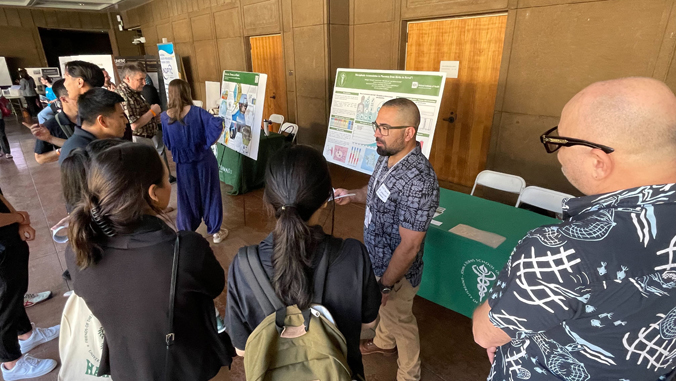
Investigating Maui wildfire impacts on nearshore beaches and waters, using AI to improve risk detection of depression among Native Hawaiians and Pacific Islanders, and alternative models for rehabilitation and restorative justice for Hawaiʻi were some of more than 50 research projects showcased at the second annual UH Mānoa Research Day at the Hawaiʻi State Capitol.

University of Hawaiʻi at Mānoa undergraduate and graduate students, faculty and staff across a variety of different disciplines delivered oral presentations, hosted informational tables and conducted interactive activities on the capitol’s 4th floor, demonstrating UH Mānoa’s research on some of Hawaiʻi‘s most pressing issues: Maui wildfire disaster, homelessness, mental health challenges, educational reform and more.
“Being involved in research improves the education of our children, of our students, and we want to demonstrate the value of that to our legislators,” said Christopher Sabine, UH Mānoa interim vice provost for research and scholarship. “We bring the research here to them so they can be exposed to it as well and see how students are able to use this to improve their education. It also helps to show the value of the research to our state in general.”
This year’s research day theme was UH Mānoa’s Kuleana to Hawaiʻi and the World: Our Commitment to Excellence in Research. Hawaiʻi lawmakers and representatives were invited to engage with UH Mānoa students, faculty and staff to learn about the wide variety and impact of research initiatives.
“What’s really awesome is the fact that the University of Hawaiʻi has such a wide range of research and knowledge, and a whole variety of topics that affect all of our lives, not just the scientific community, but affects consumers and those of us who buy foods in our everyday lives and trying to save endangered species from extinction,” said State Rep. Gregg Takayama.
Lahaina native Julynn Iʻi is a water sample specialist for the UH Mānoa Water Resources Research Center (WRRC). Iʻi and other team members are working on a project to identify drinking water contamination and social vulnerability impacts from urban fires, with a focus on the Lahaina wildfire.
“Being able to provide some sense of security to our community is very important to me,” Iʻi said. “We weren’t directly affected but we are in that zone where we were affected at the same time to where I needed to make sure that my keiki were safe and that it was safe for us to be in our own home. To be able to be a person of the community as well as a person of my ʻohana to help keep us safe, it means a lot to me and I want to assure that we continue doing this movement to better bring peace to everybody in Lahaina.”
WRRC field technician Kellie Cole added, “I’m up in Kula. We were impacted by the fires and sort of fell into this position because of the impact from the fires. It’s been really useful to be able to reach out and get to know my community and see what their needs are, see what their concerns are and be able to give them some sense of comfort and safety during this time.”
UH Mānoa also highlighted some of its recent successes, including:
- UH Mānoa is among the nation’s top 10% of higher education institutions in six key research categories, according to the latest National Science Foundation Higher Education Research and Development Data, which measures research and development expenditures across a variety of disciplines. See more in this UH News story.
- UH brought in a record $515.9 million in extramural funding in fiscal year 2023. Extramural funding is external investments from the federal government, industry and non-profit organizations that support research and academic activities conducted by university faculty and staff. UH Mānoa accounted for $342.7 million of the extramural awards. See more in this UH News story.
UH Mānoa is one of only four U.S. universities with the simultaneous designation as a land, sea, space, and sun grant institution. UH Mānoa is also one of only 95 doctoral universities categorized among public institutions with the highest research activity (Carnegie R1 designation), and is consistently ranked among the top 2% globally by major higher education rankings services.
—By Marc Arakaki

